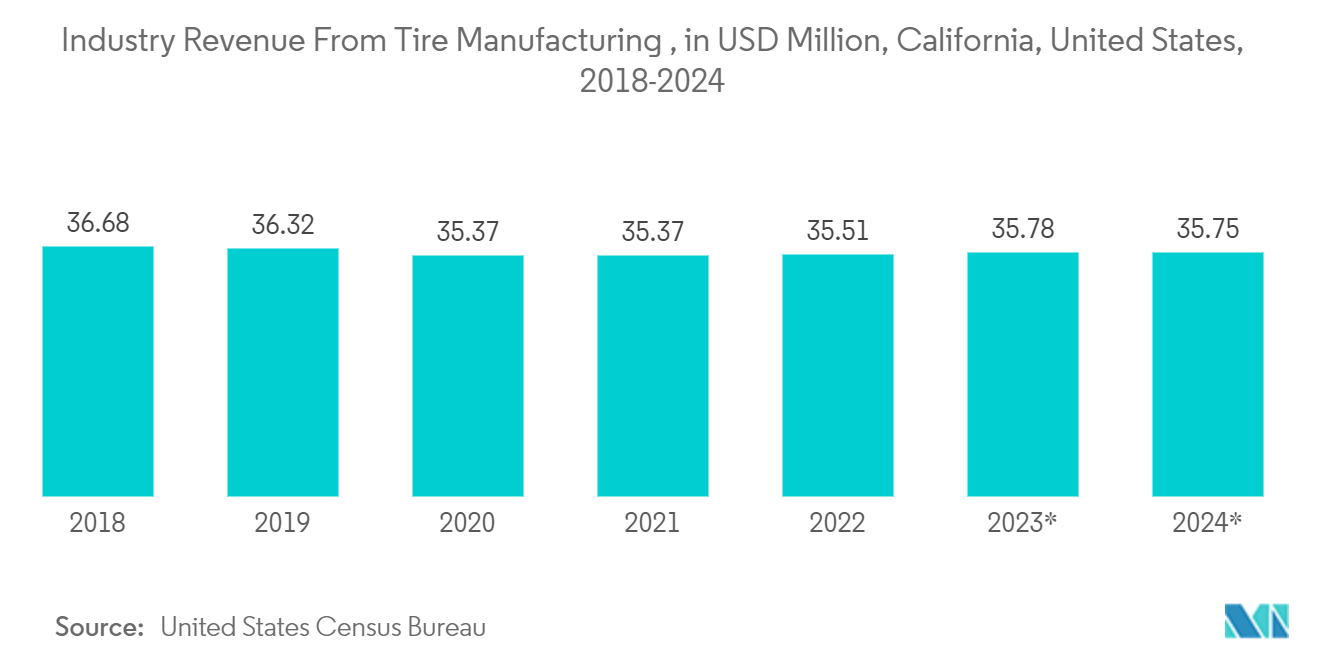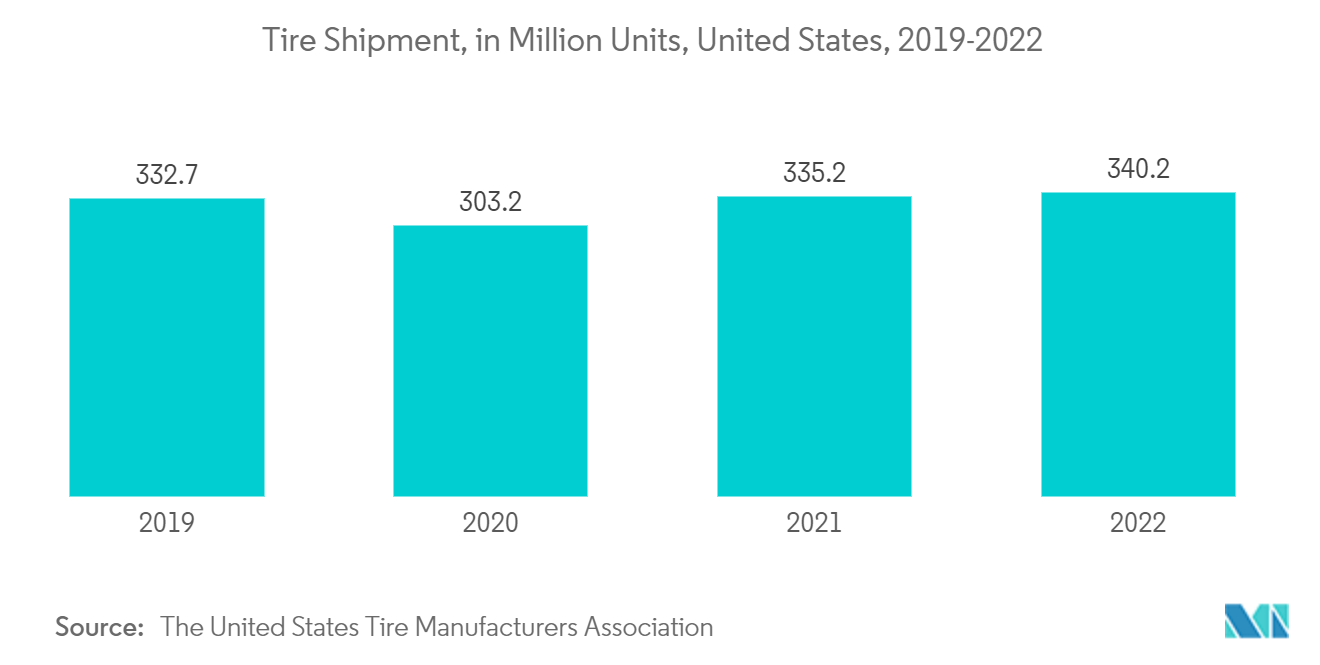Market Trends of North America Carbon Black Industry
This section covers the major market trends shaping the North America Carbon Black Market according to our research experts:
Increasing Usage in the Tire Industry
- Carbon black is one of the reinforcements frequently used in the tire industry, owing to its effect on tires' mechanical and dynamic properties. It is used in various formulations with different rubber types to customize the performance properties of tires.
- Carbon black is used in tires primarily as a filler to enhance its various characteristics, such as tread wear, fuel economy, longevity, etc.
- Carbon black is mainly required in the inner liners, sidewalls, and carcasses. It includes heat-dissipation capabilities when added to rubber compounds. It also improves handling, tread wear, and fuel mileage and provides abrasion resistance.
- Carbon black in tires includes the benefit of making rubber compositions more electrically conductive. According to chemical engineers, a tire built without carbon black would likely last 5000 miles or less. As a result, most drivers would have to replace their tires one to two times per year, which would be undesirable to most consumers.
- The United States represents one of the world's largest and most advanced tire markets. It is home to some of the largest tire manufacturers in the world, such as Goodyear Tire and Rubber Co., Cooper Tire and Rubber Co., Michelin, and Bridgestone Americas Tire Operations. These four companies hold over 70% of the market share.
- As per the US Census Bureau, the industry revenue of tire manufacturing in California was USD 35.37 million in 2021 and USD 35.51 million in 2022, registering a slight increase from the previous years. Thereby positively impacting the demand for the market studied.
- The tire market in Canada relies on tire imports from several countries. The tire demand is anticipated to increase from the replacement sector, as the domestic automotive fleet is growing briskly over the last several years.
- In addition, the demand for truck and bus radial (TBR) tires is also increasing in the country. It can provide a further boost for the carbon black market. For instance, ZC Rubber increased its production facilities recently to become the biggest TBR tire manufacturer in the world.
- There have various tire companies with production facilities in Mexico, including Bridgestone Corp. (two plants), Continental AG, Cooper Tire and Rubber Co., Goodyear, Michelin, JK Tyre and Industries Ltd (three plants), and Pirelli Tyre SpA. With the signing of the United States-Mexico-Canada Agreement (USMCA), stability returned to Mexican automotive production. It will result in an exciting market scenario for domestic tire production. The tire industry in Mexico is expected to receive a massive boost owing to huge investments from leading global tire manufacturers.
- Additionally, with the increasing demand for lightweight and electronic vehicles in the region, the demand for carbon black is expected to increase further during the forecast period.
- Due to all such factors, the market for carbon black in the North American region is expected to have steady growth during the forecast period.

United States to Dominate the Market
- In the North American region, the United States is one of the leading economies in terms of GDP. The United States is the largest producer and consumer of the carbon black market after China. The country produces more than 1.6 million metric tons of carbon black, with the support of 15 operating plants by market giants, like Cabot Corporation, Birla Carbon, Continental Carbon Co. (China Synthetic Rubber Corp.), Tokai Carbon (Sid Richardson Carbon and Energy Co.), and Orion Engineered Carbons.
- Carbon black is used in different industries in the United States, such as tires, plastics, paints and coatings, textile fibers, etc.
- As per the US Tire Manufacturers Association (USTMA) data, in 2022, the total tire shipments in the United States amounted to around 340.2 million units, compared to 335.2 million units in 2021 and 332.7 million in 2019.
- Over the years, the US rubber industry grew by leaps and bounds. The country continues to be a significant force in terms of rubber consumption. Apart from being a major producer and consumer of synthetic rubber (SR), the industry produces a host of specialty rubber chemicals and is home to a booming USD 130 billion medical devices market. The demand for rubber in the country is projected to reach USD 10 billion by the end of the forecast period.
- According to the American Coatings Association (Coatings Tech), the paints and coatings industry in the United States accounted for USD 25.21 billion in 2020 and reached USD 28.06 billion in 2022. Similarly, in terms of volume, the paints and coatings industry stood at 1,337 million gallons in 2020 and reached 1,416 million gallons in 2022. It is likely to enhance the demand for carbon black from the paints and coatings sector in the country.
- In the United States, the demand for home paints accounts for about 40% of the total paints and coatings industry revenue; commodity finishes for 25%; special-purpose coatings for 20%; and varnish removers and paint thinners own 5%. Therefore, increasing demand and production of paints have boosted the demand for carbon black during the forecasted period.
- The United States is the world'sworld's second-largest individual country exporter of textile-related products. The textile and apparel manufacturing in the country is fluctuating. Non-apparel textile products, such as industrial and home textiles, are becoming a more critical part of the industry. The government also imports textile and apparel products from other foreign countries due to the high cost of capital and labor in the domestic market.
- The flexible packaging market in the country is driven by high demand for food and beverage, pharmaceuticals and medicals, retail bags, and other non-food-related products. The changing trends in consumer behavior and manufacturers' more accessible convenience have benefitted the flexible packaging market to grow faster in the country, further benefiting the printing ink market.
- Moreover, the packaging industry is expected to grow at a moderately high rate in the country, owing to the current government'sgovernment's supportive policies. However, the growth of printing ink from the packaging industry is compensated by the decline in the commercial and publications industry as most people in the country are shifting to e-books and other sources.
- Therefore, all the above factors will likely boost the demand for the carbon black market in the country during the forecasted period.

